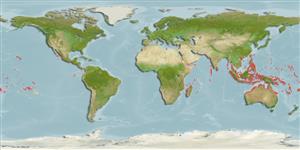>
Mugiliformes (Mullets) >
Mugilidae (Mullets)
Eponymy: Chris Engel was a prolific scientific illustrator who provided many of the illustrations in Bleeker’s works, including his monumental 36–volume Atlas Ichthyologique des Orientales Neerlandaises (1862–1878). (Ref. 128868), visit book page.
More on author: Bleeker.
Environment: milieu / climate zone / depth range / distribution range
Ecologia
marino; salmastro associati a barriera corallina; distribuzione batimetrica 0 - 3 m (Ref. 86942). Tropical; 25°N - 24°S
Indo-Pacific: East Africa to the Marquesan and Tuamoto islands, north to the Yaeyamas. At least one country reports adverse ecological impact after introduction.
Size / Peso / Age
Maturity: Lm ? range ? - ? cm
Max length : 47.7 cm FL maschio/sesso non determinato; (Ref. 107958); common length : 25.0 cm TL maschio/sesso non determinato; (Ref. 2871)
Spine dorsali (totale) : 4; Raggi dorsali molli (totale) : 9 - 10; Spine anali: 3; Raggi anali molli: 8 - 9. Olive dorsally; flanks and abdomen silvery; fins hyaline (Ref. 9812). Pectoral fins with dark spot dorsally at origin (Ref. 9812).
Inhabit shallow protected sandy to muddy areas of reef flats and shallow lagoons while juveniles have been encountered in tide pools (Ref. 205). Benthopelagic (Ref. 58302). Oviparous, eggs are pelagic and non-adhesive (Ref. 205). Marketed fresh and used as live bait in pole-and-line fishing for tuna (Ref. 9812).
Life cycle and mating behavior
Maturità | Riproduzione | Deposizione | Uova | Fecundity | Larve
Myers, R.F., 1991. Micronesian reef fishes. Second Ed. Coral Graphics, Barrigada, Guam. 298 p. (Ref. 1602)
IUCN Red List Status (Ref. 130435: Version 2024-1)
Threat to humans
Potential pest (Ref. 6362)
Human uses
Pesca: commerciale; esca: occasionally
Strumenti
Special reports
Download XML
Fonti Internet
Estimates based on models
Preferred temperature (Ref.
123201): 25.4 - 29.3, mean 28.5 °C (based on 2596 cells).
Phylogenetic diversity index (Ref.
82804): PD
50 = 0.5625 [Uniqueness, from 0.5 = low to 2.0 = high].
Bayesian length-weight: a=0.01148 (0.00992 - 0.01328), b=2.96 (2.92 - 3.00), in cm total length, based on LWR estimates for this species (Ref.
93245).
Resilienza (Ref.
120179): Medio, tempo minimo di raddoppiamento della popolazione 1.4 - 4.4 anni (Preliminary K or Fecundity.).
Fishing Vulnerability (Ref.
59153): Moderate vulnerability (41 of 100).
Nutrients (Ref.
124155): Calcium = 58.9 [22.6, 189.0] mg/100g; Iron = 0.634 [0.276, 1.477] mg/100g; Protein = 18.9 [17.0, 20.7] %; Omega3 = 0.144 [0.068, 0.312] g/100g; Selenium = 20.5 [10.0, 48.2] μg/100g; VitaminA = 62.8 [13.5, 283.1] μg/100g; Zinc = 2.01 [1.23, 3.10] mg/100g (wet weight);
